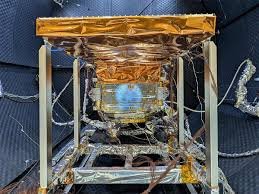A new era of weather forecasting is set to begin as the Etihad-SAT satellite prepares for launch in March 2025. This advanced satellite is designed to improve weather prediction, monitor climate changes, and help mitigate the impact of extreme weather events. With cutting-edge technology on board, Etihad-SAT promises to provide more accurate and timely data for meteorologists and climate experts worldwide. This marks a major step forward in space-based weather tracking, promising better insights into natural disasters, changing climates, and unpredictable atmospheric shifts.
A Revolutionary Leap in Weather Forecasting
Etihad-SAT is a state-of-the-art weather monitoring satellite developed to enhance global forecasting capabilities. It will track storms, measure temperature variations, and analyze atmospheric changes with high precision. Scientists and researchers believe this satellite will significantly improve disaster preparedness by providing early warnings for hurricanes, typhoons, and other severe weather conditions.

Weather-related disasters cause billions of dollars in damages each year, and the need for more accurate forecasting has never been greater. With unpredictable climate changes and extreme weather events becoming more common, a satellite like Etihad-SAT will serve as a crucial tool for meteorological agencies and governments worldwide.

Why is Etihad-SAT Important?

- More Accurate Weather Predictions: The satellite will collect and transmit real-time weather data, helping meteorologists make better forecasts.
- Climate Change Monitoring: It will track temperature changes and greenhouse gas emissions, providing valuable insights into global warming trends.
- Disaster Prevention: By detecting weather patterns early, authorities can issue warnings and take preventive measures to save lives and reduce damage.
- Global Data Sharing: Information collected by the satellite will be shared with international weather agencies, improving global cooperation in climate science and disaster response.
Cutting-Edge Technology Behind Etihad-SAT
The satellite is equipped with advanced imaging systems, high-resolution cameras, and infrared sensors. These features allow it to capture detailed images of clouds, oceans, and landmasses. The satellite will also have artificial intelligence (AI) capabilities to process vast amounts of data quickly and identify weather patterns with high accuracy.
Moreover, Etihad-SAT will be connected to a global network of weather stations, ensuring that scientists and meteorologists receive up-to-the-minute information. This will help improve the accuracy of weather models used for predicting storms, rainfall, and climate shifts.
The satellite will also be fitted with hyperspectral imaging technology, which allows it to analyze different layers of the Earth’s atmosphere with remarkable precision. This means it will not only track large weather patterns but also detect subtle environmental changes that could indicate emerging weather threats.
How Will Etihad-SAT Benefit the World?
The launch of Etihad-SAT is expected to bring multiple benefits, not just for meteorologists but for various industries, governments, and communities worldwide.
- Improved Agricultural Planning Farmers rely on weather forecasts to plan their planting and harvesting seasons. With Etihad-SAT providing precise weather updates, farmers can make better decisions, leading to increased crop yields and food security. Drought-prone regions will especially benefit from more detailed rainfall predictions, allowing better water management and crop selection.
- Better Disaster Management The satellite’s ability to detect severe weather conditions early will allow emergency response teams to prepare in advance. This will help minimize casualties and property damage during storms, floods, and wildfires. Countries vulnerable to hurricanes, tornadoes, and monsoons will gain better insights into the severity and movement of these weather phenomena, leading to faster and more effective disaster response strategies.
- More Efficient Air and Sea Travel Airlines and shipping companies depend on accurate weather forecasts to avoid turbulence and rough seas. Etihad-SAT’s data will help pilots and ship captains plan safer routes, reducing delays and preventing accidents. Maritime industries will benefit from improved predictions of sea conditions, making ocean transport safer and more efficient.
- Advancements in Scientific Research Scientists studying climate change, environmental shifts, and atmospheric behavior will gain access to a wealth of new data from Etihad-SAT. This information will help researchers understand how human activities are impacting the planet and contribute to strategies aimed at reducing carbon footprints and mitigating climate change effects.
- Urban and Infrastructure Planning Cities facing extreme weather challenges, such as flooding or heat waves, will be able to use satellite data to design better infrastructure and drainage systems. Governments will be better equipped to build resilient cities that can withstand the challenges posed by climate change.
Launch Details and Future Plans
The satellite is set to be launched in March 2025 aboard a high-powered rocket from a well-established space center. Scientists and engineers have spent years developing and testing Etihad-SAT to ensure it meets international standards for weather monitoring and space safety. Extensive simulations and prototype testing have been conducted to ensure the satellite can withstand space conditions and function efficiently in orbit.
After its launch, the satellite will enter Earth’s orbit and start transmitting data to ground stations. Researchers will analyze this information to refine weather models and improve forecasting techniques. The satellite is expected to have a long operational lifespan, providing crucial data for at least a decade.
Experts believe that Etihad-SAT is just the beginning. Future satellites with even more advanced technology could further enhance our ability to predict and respond to climate changes. The success of this mission could pave the way for similar projects, leading to a global network of high-tech weather monitoring satellites that ensure more precise, timely, and widespread data collection.
Conclusion
The upcoming launch of Etihad-SAT marks a significant milestone in weather monitoring technology. Its ability to provide real-time, high-quality weather data will help protect lives, support industries, and enhance climate research. As we move towards a future where extreme weather events are becoming more frequent, satellites like Etihad-SAT will play a crucial role in keeping the world informed and prepared.
By offering more precise weather forecasting, enhancing disaster response, and contributing to climate science, Etihad-SAT will be an invaluable asset in the fight against climate-related challenges. With the satellite set to launch in just a few months, anticipation is growing for the benefits it will bring to meteorology and beyond.
Also read: UAE’s New Investment Policies Are Boosting Economic Growth and Stability












